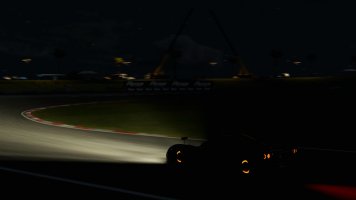Getting to grips with all sorts of changing conditions is essential in racing, especially in endurance events. Of course, this does not just mean weather, but also the day/night cycle and changing visibility as it gets darker. Racing at night tends to look spectacular, but can be much more difficult - or even helpful for others.
Image credit: Reiza Studios
There is no denying the atmosphere of endurance races running into the dusk, with the available light becoming less and less by the minute until the cars headlights eventually cut through the darkness of the night that has just set in. What is an optical treat for spectators at the track and on TV is of course a more difficult scenario for the drivers, and in sim racing, this is not any different.

Getting around other cars in the dark may prove to be trickier than during the day. Image credit: Kunos Simulazioni
Adding to this, once the night rolls around in 24-hour races, fatigue might set in, potentially increasing reaction times and making it harder to concentrate on what is going on around the car. As a result, some drivers tend to avoid driving at night - and leave it to others who thrive in these conditions.
Distractions from your own team tend to be less frequent as well, as most of the co-drivers that do not have to be in the car until later on usually try and get some sleep to rest up for their stints. In that sense, it is an advantage for drivers who can get lost in doing laps like clockwork and do not mind driving the late-night stints.

Just because the sun is down, does not mean the on-track action stops. Image credit: Kunos Simulazioni
Of course, the fatigue argument does not normally apply when night races are driven when the real-life clock shows that it is daytime, but the challenge of driving in the dark is still there. And it tends to be a great environment for quick laps as the temperatures drop, leading to considerable improvements on personal bests during night stints.
Image credit: Reiza Studios
There is no denying the atmosphere of endurance races running into the dusk, with the available light becoming less and less by the minute until the cars headlights eventually cut through the darkness of the night that has just set in. What is an optical treat for spectators at the track and on TV is of course a more difficult scenario for the drivers, and in sim racing, this is not any different.
Now, where to brake again?
Braking points get more difficult to spot, trailing cars only appear as blinding lights in the rear view mirror, and unlit parts of the track descend into darkness - drivers need to adapt to these things in some endurance races, and even more so if the weather changes. Racing at night and in the rain is quite a challenge, especially if a race features multiple classes and you might not immediately be able to tell which class the set of lights you are coming up on belongs to.Getting around other cars in the dark may prove to be trickier than during the day. Image credit: Kunos Simulazioni
Adding to this, once the night rolls around in 24-hour races, fatigue might set in, potentially increasing reaction times and making it harder to concentrate on what is going on around the car. As a result, some drivers tend to avoid driving at night - and leave it to others who thrive in these conditions.
Entering The Zone
The limited visibility can work as a tunnel of sorts, tuning out possible distractions and allowing drivers to enter the zone - a phenomenon we have highlighted before - much easier as things seems less frantic than at the start and in bright daylight. The race has usually settled into a rhythm at this point, allowing drivers to put in lap after lap while simply focusing on their own race.Distractions from your own team tend to be less frequent as well, as most of the co-drivers that do not have to be in the car until later on usually try and get some sleep to rest up for their stints. In that sense, it is an advantage for drivers who can get lost in doing laps like clockwork and do not mind driving the late-night stints.
Just because the sun is down, does not mean the on-track action stops. Image credit: Kunos Simulazioni
Of course, the fatigue argument does not normally apply when night races are driven when the real-life clock shows that it is daytime, but the challenge of driving in the dark is still there. And it tends to be a great environment for quick laps as the temperatures drop, leading to considerable improvements on personal bests during night stints.

